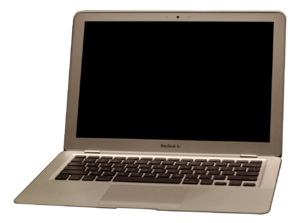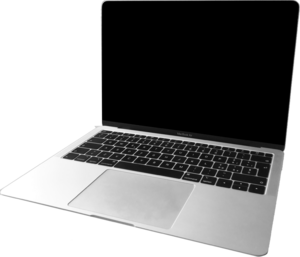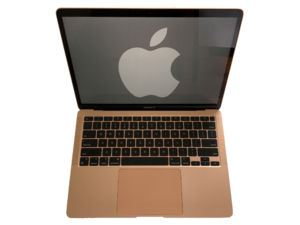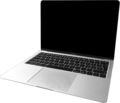MacBook Air facts for kids
The MacBook Air is a super thin and light laptop made by Apple Inc.. It has a full-size keyboard and a strong case made from aluminum.
When it first came out, the MacBook Air was a fancy, expensive laptop. But over time, it became Apple's most affordable notebook. Today, it sits below the more powerful MacBook Pro in Apple's lineup.
The first MacBook Air with Intel chips was launched in January 2008. It had a 13.3-inch screen and was known as the world's thinnest laptop. This started a new type of laptop called an ultrabook. In October 2010, Apple released a new version. It had a cool, tapered shape and came with a smaller 11.6-inch screen option. Later models got faster processors and new Thunderbolt ports.
A third generation came out in October 2018. It was even smaller and lighter. It featured a super clear Retina display and modern USB-C ports. In February 2020, an updated model arrived with the improved Magic Keyboard.
A big change happened in November 2020. Apple released the first MacBook Air with its own special chip, the Apple M1 processor. Then, in June 2022, Apple announced a new design for the MacBook Air with an even faster Apple M2 processor.
Contents
Intel-based MacBook Airs
First Generation (Unibody)
Steve Jobs showed off the first MacBook Air on January 15, 2008. This 13.3-inch model was famous for being the thinnest laptop in the world at just 1.9 centimeters (0.75 inches) thick.
It had a special Intel processor and graphics chip. The screen was bright with LED backlighting. It also featured a full-size keyboard and a large trackpad. This trackpad could understand multi-touch gestures, like pinching to zoom or swiping.
The MacBook Air was Apple's first small laptop since 2006. It was also the first Apple computer to offer an optional solid-state drive (SSD). This type of storage is much faster than traditional hard drives. Unlike older laptops, it didn't have a built-in CD/DVD drive. Users could buy an external drive or share one wirelessly from another computer. It also didn't have a FireWire or Ethernet port.
On October 14, 2008, a new model came out with a faster processor and Nvidia graphics. The storage options improved, with a 128 GB SSD or a 120 GB hard drive. The video port was updated to Mini DisplayPort. A mid-2009 version had a slightly better battery and a faster processor.
Second Generation (Tapered Unibody)
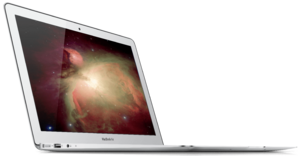
On October 20, 2010, Apple released a completely new 13.3-inch MacBook Air. It had a cool, tapered shape, a sharper screen, and a better battery. It also gained a second USB port and stereo speakers. This model came with a solid state storage as standard.
Apple also introduced a smaller 11.6-inch model. This version was lighter and more affordable. Both the 11-inch and 13-inch models had a headphone jack. The 13-inch model also got an SD Card slot.
On July 20, 2011, Apple updated these models. They became Apple's main entry-level laptops. These mid-2011 models got faster Intel Core i5 and i7 processors. They also included Intel HD Graphics 3000, backlit keyboards, Thunderbolt ports, and Bluetooth 4.0. Storage options went up to 256 GB.
On June 11, 2012, the line was updated again. They received even faster Intel Core i5 and i7 processors and HD Graphics 4000. They also got faster storage, USB 3.0 ports, and an improved 720p FaceTime camera. The charging port became thinner with MagSafe 2. The standard memory was 4 GB, and you could get up to 8 GB.
On June 10, 2013, Apple updated the laptops with new Haswell processors. These greatly improved battery life. The 11-inch model could last 9 hours, and the 13-inch model could last 12 hours! They also got faster Wi-Fi.
In March 2015, the models were refreshed with Broadwell processors and faster storage. In 2017, the 13-inch model got a slightly faster processor. The 11-inch model was stopped. The 2017 model was sold until July 2019. It was the last Apple laptop with older USB Type-A ports and a non-Retina display.
Third Generation (Retina)
On October 30, 2018, Apple released the third generation MacBook Air. It had a beautiful 13.3-inch Retina display with super sharp resolution. It also included Touch ID for fingerprint security. It came with two modern USB-C/Thunderbolt 3 ports and an audio jack.
The new screen showed 48% more colors. The edges around the screen (bezels) were 50% thinner. The laptop itself was 17% smaller in volume. It was also thinner at 15.6mm and weighed 1.25 kg (2.75 pounds). You could buy it in silver, space gray, or gold.
The basic 2018 model came with 8 GB of RAM and a 128 GB SSD. It had an Intel Core i5 processor.
Apple updated these models in July 2019. They added True Tone display technology, which adjusts the screen's color based on your surroundings. They also used an updated butterfly keyboard.
In March 2020, new models were released with faster Intel Core i3, i5, and i7 processors. They had improved graphics and could connect to 6K monitors. The butterfly keyboard was replaced with the more reliable Magic Keyboard.
Apple Silicon MacBook Airs
Third Generation (Retina with Apple Silicon)
On November 10, 2020, Apple announced a new Retina MacBook Air. This was a huge step because it used Apple's own M1 processor. This was the first MacBook Air to use Apple's custom chips, which are based on ARM technology.
This M1 MacBook Air was designed without a fan, making it super quiet. It also supported faster Wi-Fi 6 and USB4/Thunderbolt 3. The screen could show a wider range of colors (P3). Reviewers loved the M1 MacBook Air for its amazing speed and long battery life.
As of July 2022, the MacBook Air M1 started at $999 USD.
Fourth Generation (Flat Unibody)
On June 6, 2022, Apple announced their second-generation chip, the M2 processor. The first computer to get this new chip was a completely redesigned MacBook Air.
This new design is much thinner and flat, moving away from the old wedge shape. It looks similar to the newer 14-inch and 16-inch MacBook Pro laptops. It's 20% smaller in volume than the previous MacBook Air.
Other cool features include MagSafe 3 for charging, which can quickly charge the battery to 50% in 30 minutes. It has a taller 13.6-inch Liquid Retina display that is 25% brighter. The FaceTime camera is now 1080p, offering clearer video calls. It also has a great four-speaker sound system with Spatial Audio. You can get it in silver, space gray, starlight (a silver-gold color), and midnight (a dark blue-black color).
As of July 2022, the MacBook Air (Flat Unibody) M2 started at $1199 USD.
Supported Operating Systems
The MacBook Air runs on Apple's macOS operating system. Different models support different versions of macOS. For example, the M1 and M2 MacBook Airs support the latest versions like macOS Big Sur, macOS Monterey, and MacOS Ventura. Older Intel-based models support earlier versions of macOS.
Intel-based MacBook Airs can also run Microsoft Windows using a special program called Boot Camp. However, Apple silicon models (M1, M2) do not support Boot Camp.
See also
 In Spanish: MacBook Air para niños
In Spanish: MacBook Air para niños
Images for kids
-
Left side of a second generation MacBook Air. From left to right, MagSafe 2 power connector, USB port, headphone jack and built-in microphone.


